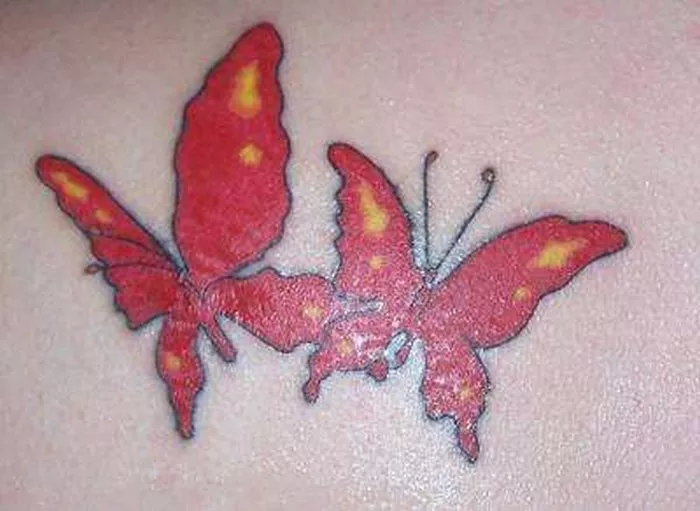In the realm of body art, tattoos often carry profound meanings, serving as expressions of identity, experiences, and emotions. Among the myriad designs, the butterfly tattoo stands out as a symbol rich in metaphorical significance. While commonly associated with beauty, transformation, and freedom, its interpretation takes on a deeper dimension when viewed through the lens of mental health, particularly depression. Exploring the connection between butterfly tattoos and depression unveils a narrative of resilience, hope, and personal growth amid adversity.
The Metaphor of Transformation: From Darkness to Light
At its core, depression is characterized by feelings of despair, emptiness, and the pervasive sense of being trapped in darkness. Individuals grappling with this mental health condition often seek solace and catharsis through various means, including art and self-expression. The butterfly, with its remarkable metamorphosis from a humble caterpillar to a creature of stunning beauty, encapsulates the essence of transformation—a journey from confinement to liberation.
In the context of depression, the butterfly tattoo serves as a visual representation of the inner metamorphosis experienced by individuals navigating their mental health struggles. Just as the caterpillar undergoes a profound change within the confines of its cocoon, those battling depression undergo a transformative journey within themselves. The tattoo serves as a reminder of their resilience, symbolizing the hope for eventual emergence from the darkness of depression into the light of healing and recovery.
Symbolism of Hope and Resilience
Depression often robs individuals of hope, leaving them feeling helpless and devoid of optimism for the future. In such bleak moments, the symbolism of the butterfly tattoo offers a beacon of hope, reminding individuals that change is possible, and that even the most profound struggles can lead to growth and renewal.
The butterfly’s ability to emerge from its cocoon and take flight represents resilience in the face of adversity. Similarly, individuals with butterfly tattoos find strength in the symbolism, reminding themselves that they possess the inner resilience to overcome their mental health challenges. The tattoo becomes a talisman of sorts, imbued with the power to uplift spirits and instill courage during moments of darkness.
Moreover, the ephemeral nature of a butterfly’s lifespan parallels the transient nature of depressive episodes. Just as the butterfly’s journey is marked by stages of growth and transformation, individuals with depression experience periods of flux, where emotions and circumstances evolve over time. The tattoo serves as a reminder that despite the fleeting nature of pain and suffering, there is always the potential for renewal and rebirth.
Personal Meaning and Empowerment
One of the most profound aspects of tattoos is their ability to carry deeply personal meanings for the wearer. While the symbolism of the butterfly tattoo in the context of depression is widely recognized, its interpretation can vary significantly from one individual to another. For some, it may symbolize overcoming past trauma or adversity, while for others, it may represent a commitment to self-care and healing.
For many individuals living with depression, the act of getting a butterfly tattoo can be a profoundly empowering experience. It serves as a tangible affirmation of their journey towards mental wellness, a visible marker of their commitment to self-care and self-expression. In a society where mental health struggles are often stigmatized or misunderstood, the tattoo becomes a statement of defiance—a declaration that their experiences are valid, and that they refuse to be defined by their illness.
Furthermore, the process of choosing and designing the tattoo can be therapeutic in itself, allowing individuals to reclaim agency over their bodies and their narratives. Whether it’s selecting a design that resonates personally or collaborating with a tattoo artist to create a custom piece, the act of getting a butterfly tattoo can be a cathartic exercise in self-discovery and self-expression.
Breaking the Stigma: Spreading Awareness Through Art
In recent years, there has been a growing movement to destigmatize mental illness and promote open discussions about mental health. Art, including tattoos, has emerged as a powerful medium for spreading awareness and sparking conversations about depression and other mental health conditions.
Butterfly tattoos, in particular, have become a symbol of solidarity among individuals affected by depression. By proudly displaying their tattoos, individuals signal their support for mental health awareness and advocacy, encouraging others to seek help and support without shame or judgment.
Moreover, the visibility of butterfly tattoos in popular culture and social media platforms has helped to normalize conversations about mental health. Celebrities and influencers sharing their own experiences with depression and the significance of their butterfly tattoos have helped to humanize the condition, fostering empathy and understanding among the general public.
Conclusion
In conclusion, the symbolism of the butterfly tattoo in the context of depression transcends its aesthetic appeal, embodying themes of transformation, hope, and resilience. For individuals grappling with mental health challenges, the tattoo serves as a poignant reminder of their inner strength and capacity for growth.
Through its symbolism, individuals find solace in the belief that their struggles are not in vain—that like the butterfly emerging from its cocoon, they too can experience a profound metamorphosis and emerge stronger and more resilient than before. Moreover, the visibility of butterfly tattoos in popular culture and social media platforms has helped to destigmatize conversations about depression, fostering a greater sense of empathy and understanding.
Ultimately, the butterfly tattoo serves as a beacon of hope in the darkness of depression, a reminder that even in the depths of despair, there is always the potential for renewal and transformation. As more individuals embrace this powerful symbol of resilience and empowerment, we move one step closer to creating a world where mental health is recognized, supported, and celebrated.

